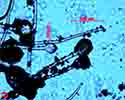
Detection of Aspergillus flavus using PCR method from fungus infested food grains collected from local market
Abstract
India is an agrarian country two-thirds of its population is engaged directly or indirectly in agricultural activities. In recent years many food borne pathogens have become major threat to public health and safety. The consumption of contaminated food grains or products has been considered to be the leading source of human food borne infections. Surveillance studies have provided data and a better understanding into the existence and spread of food borne pathogens. Aflatoxins produced by Aspergillus species are important toxic secondary metabolites known for their impacts on animal and human health, and their effects on the economic loss of key grain and nut crops. Several molecular techniques (including multilocus sequence typing, pulsed field gel electrophoresis, DNA sequencing, multiplex PCR, RAPD, and many more) are available for detection and characterisation of pathogenic microorganisms from food samples, which provide reliable epidemiological data for tracing the source of infections. Present study highlights the possible use of PCR technique, in surveillance and detection of A. flavus in fungal infested food grains. The current study was carried out to elucidate the infestation of aflatoxin producing fungus on both kharif (groundnut, rice and maize) and Rabi crops (wheat, gram and soybean). Total 15 samples were collected randomly from local market of Gwalior (M.P). Out of fifteen only nine (60%) samples were found to be Aspergillus positive. Seven samples were infested by Aspergillus flavus and two by A. niger. The selected fungal isolates were identified by amplifying aflR gene of A. flavus in Thermo Cycler.
Keywords
Full Text:
PDFReferences
Bankole S A, BM Ogunsanwo and OO Mabekoje. “Natural occurrence of moulds and aflatoxin B1 in melon seed from markets in Nigeria.” Food Chem Toxicol 2004; 42: 1309-1314.
Leontopoulos D, A Siafaka and P Markaki. “Black olives as substrate for Aspergillus parasiticus growth and aflatoxin B1 production.” J. Food Microbiol 2003; 20, 119-126.
Bennet J W and M Klich. “Mycotoxins.” Clin Microbiol Rev 2003; 16: 497-516.
Bintvihok A. “Aflatoxin contamination in shrimp feed and effect of aflatoxin addition to feed on shrimp production.” J Food Protection 2003; 66(5):882-885.
Kumar P, D K Mahato, M Kamle, T K Mohanta and S G Kang. “Aflatoxins: A Global Concern for Food Safety, Human Health and Their Management.” Front Microbiol 2016; 7: 2170.
Inan F, M Pala, and I Doymaz. “Use of ozone in detoxification of aflatoxin B1 in red pepper.” J Stored Prod Res 2007; 43: 425–429.
Giray B, G Girgin, A B Engin, S Aydın and G Sahin. “Aflatoxin levels in wheat samples consumed in some regions of Turkey.” Food Control 2007; 18: 23–29.
Hussain I and J Anwar. “A study on contamination of aflatoxin M1 in raw milk in the Punjab province of Pakistan.” Food Control 2008; 19: 393–395.
Meyers D, G Obrian, W Du, D Bhatnagar and G Payne. “Characterization of aflJ, a gene required for conversion of pathway intermediates to aflatoxin.” Appl Environ Microbiol 1998; 64: 3713–3717.
Bhatnagar D, J Cary, K Ehrlich, J Yu, and T Cleveland. “Understanding the genetics of regulation of aflatoxin production and Aspergillus flavus development.” Mycopathology 2006; 262: 255–266.
Yu J, P K Chang, K C Ehrlich, J W Cary, D Bhatnagar, T E Cleveland, G A Payne, J E Linz, C P Woloshuk and J W Bennett. “Clustered pathway genes in aflatoxin in biosynthesis.” Appl Environ Microbiol 2004; 70: 1253-1262.
Levin R E. “PCR detection of aflatoxin producing fungi and its limitations.” Int J Food Microbiol 2012; 1:156(1):1-6.
Bhatnagar D. “Enzymological evidence for separate pathways for aflatoxin B1 and B2 biosynthesis.” Biochemistry 1991; 30: 4343-4350.
Hashim A, A Al-Kazaz and Abdulmalek. “PCR Detection of Aspergillus flavus Isolates for Aflatoxin B1 producer.” Journal of Biotechnology Research Center 2013; 7 (3): 81-89.
Thilagam R, N Hemalatha, E Poongothai and G Kalaivani. “Identification of Aspergillus species isolated from corn and peanuts in storage godowns.” Int J Pharm Bio Sci 2016; 7(4): 600- 606.
Aamir S, S Sutar, S K Singh and A Baghela. “A rapid and efficient method of fungal genomic DNA extraction, suitable for PCR based molecular methods.” Plant Pathology and Quarantine 2015; 5(2):74–81.
Farber P, R Geisen and W H Holzapfe. “Detection of aflatoxigenic fungi in figs by a PCR reaction.” Int J Food Microbiol 1997; 36: 215–220.
Shapira R, N Paster, O Eyal, M Menashero, A Mett and R Salomon. “Detection of aflatoxigenic mold in grain by PCR.” App Environ Microbiol 1996; 62: 3270–3273.
Manonmani H K, S Anand, A Chandrashekar and E R Rati. “Detection of aflatoxigenic fungi in selected food commodities by PCR.” Process Biochem 2005; 40: 2859–2864.
Mateo E M, J G Serna, B Patiño and M Jiménez. “Aflatoxins and ochratoxin A in stored barley grain in Spain and impact of PCR-based strategies to assess the occurrence of aflatoxigenic and ochratoxigenic Aspergillus spp.” Intl J Food Microbiol 2011; 149(2): 118-26.
DOI: https://doi.org/10.21746/aps.2018.7.2.16
Copyright (c) 2018 Annals of Plant Sciences

This work is licensed under a Creative Commons Attribution-NonCommercial-NoDerivatives 4.0 International License.


